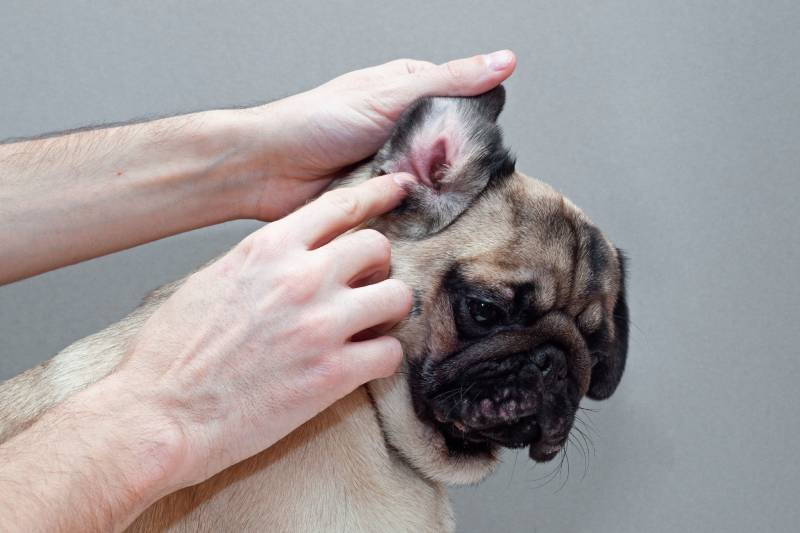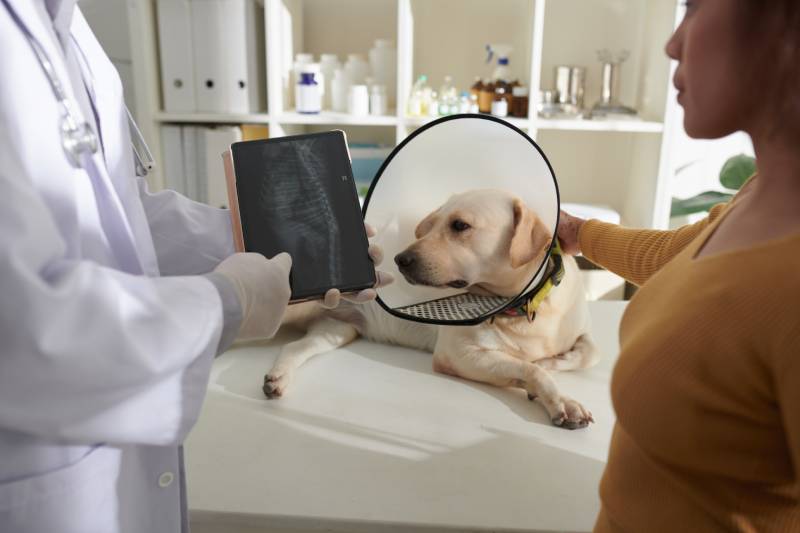My Puppy is Wobbly and Off Balance: 7 Vet-Approved Reasons Why
Updated on

Is your puppy wobbly and off balance while they are walking? If they are still young and haven’t yet begun walking steadily, this may be completely normal as they learn how to walk independently. However, if they have been walking, playing, and jumping just fine and it is a new behavior, it could be a sign that something is wrong. The name for this uncoordinated gait is ataxia. It’s best to have your veterinarian evaluate your puppy so it can be treated for whatever is causing these concerning signs.
The 7 Reasons Why My Puppy is Wobbly and Off Balance All of a Sudden
1. Otitis (Ear Problems)

Otitis, usually caused by infections, can cause loss of balance in dogs just as they can in humans.1
The problem usually starts in the outer portion of the ear and can progress to the deeper structures, being called otitis media or interna. Some breeds are more susceptible to ear infections, especially those with long, droopy ears, but any dog breed can be affected.
- Head shaking
- Scratching at the affected ear
- Head tilting
- Abnormal eye movement
- Circling
- Deafness
- Drooling
- Difficulty eating
2. Injury/Trauma
A head injury is more common in puppies than many dog owners realize.2 Sometimes, it can be prevented by adapting your home to your new dog. Falls or blunt trauma can have serious consequences on your puppy. If you notice your puppy suffering from a big shock, monitor very closely and contact your vet immediately for advice.
- Lethargy
- Dazed appearance
- Paralysis
- Abnormal pupils
- Seizures
- Circling
- Pacing
- Abnormal breathing
- Abnormal heart rhythm
3. Toxins

Puppies can be mischievous and get into things that can make them sick. Cleaning chemicals, pesticides, and other poisons can be extremely toxic to pets. New dog owners must be aware of other everyday household items that can also be toxic to puppies, like plants, human foods, human medications, and non-edible items they might chew on, like plastic and wood. However, even the best-laid plans to keep puppies safe can go wrong with the most determined puppies.
- Diarrhea
- Vomiting
- Lethargy
- Drooling
- Behavioral changes
- Fainting
- Seizures
4. Low Blood Sugar Levels (Hypoglycemia)
Puppies are at higher risk of suffering from hypoglycemia because they can’t regulate their blood sugar levels completely, especially those under 3 months of age and toy breeds. It can occur after a digestive upset with vomiting and diarrhea, heavy burden of intestinal parasites, or if your puppy has been off their food for a period of time.
Providing proper nutrition on a routine schedule is crucial to avoid this problem as well as contacting your vet as soon as you notice that your puppy goes off their food or becomes sick.
- Weakness
- Twitching or shaking
- Head tilt
- Collapse
- Seizures
5. Tumors
Tumors are very rare in puppies and usually occur in adult to senior dogs. There doesn’t seem to be a definitive cause for most tumors in dogs3, especially those of the brain, that are most likely to cause a wobbly walk for puppies. However, many breeds, especially pure-bred dogs, are more susceptible to them. These include the Boston Terrier, Boxer, and Golden Retriever.
Two of the most common types of brain tumors in dogs are meningiomas and gliomas.
- Seizures
- Abnormal behavior
- Vision loss
- Circling
6. Stroke

Stroke is rare in puppies, but it involves a sudden interruption of blood supply to any part of the brain. They occur as a consequence of other diseases that are common in middle-age to older dogs, not in puppies. Some breeds are at higher risk, such as Cavalier King Charles Spaniel and Greyhounds.
A stroke in pets is much less common than in humans because they rarely have the same risk factors. A stroke caused by a blood clot is not the same as a heat stroke, but it may be a contributing factor.
- Howling
- Difficulty walking
- Head tilt
- Behavioral changes
- Abnormal eye movement
- Blindness
- Seizures
7. Encephalitis

Encephalitis is the clinical name for inflammation of the brain. When other parts of the central nervous system are affected, the problem can be called encephalomyelitis (the spinal cord is also affected) or meningitis (the membrane that surrounds the brain and spinal cord are inflamed). The official diagnosis will depend on the area of the nervous system affected. It could be the spine or a specific area of the brain. Each area will usually display a very specific set of signs, making it much easier to diagnose.
An infection usually causes encephalitis in puppies but may also be idiopathic, meaning it doesn’t have any known cause.
- Seizures
- Blindness
- Circling
- Head tilt
- Behavioral changes
- Facial paralysis
FAQS About Ataxia in Puppies
Do you have other questions about your puppy walking off balance? You aren’t the only one. These are some of the most frequently asked questions by puppy owners experiencing a wobbly walking pup.
Is it normal for a puppy to be off balance?
It is certainly not normal for a puppy to walk wobbly, and they should see a vet as soon as possible to find out the cause.

What other signs should I look for?
Other signs that usually accompany ataxia include circling, pacing, head tilting, and behavioral changes. More severe reactions may even include blindness, seizures, and fainting. You should note any abnormalities and share these with their veterinarian. Filming a short video can be very helpful for your veterinarian or neurologist.
How is an off-balance puppy treated?
The right treatment for your puppy will depend on the diagnosis. An ear infection will be treated much differently than low sugar levels or meningitis. Therefore, it is important to get your pup to a veterinarian as soon as possible.
Conclusion
A wobbly gait or shaking while standing, tremors, or collapse are all uncommon signs in puppies and indicate that something is wrong. You should call your veterinarian and have your puppy evaluated as soon as possible to find the underlying cause so it can be treated immediately. Be sure to note any additional signs since they can help your vet accurately diagnose the condition.
.
Featured Image Credit: Taylor Treadgold, Shutterstock












